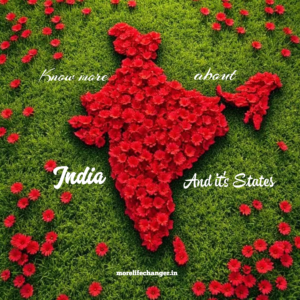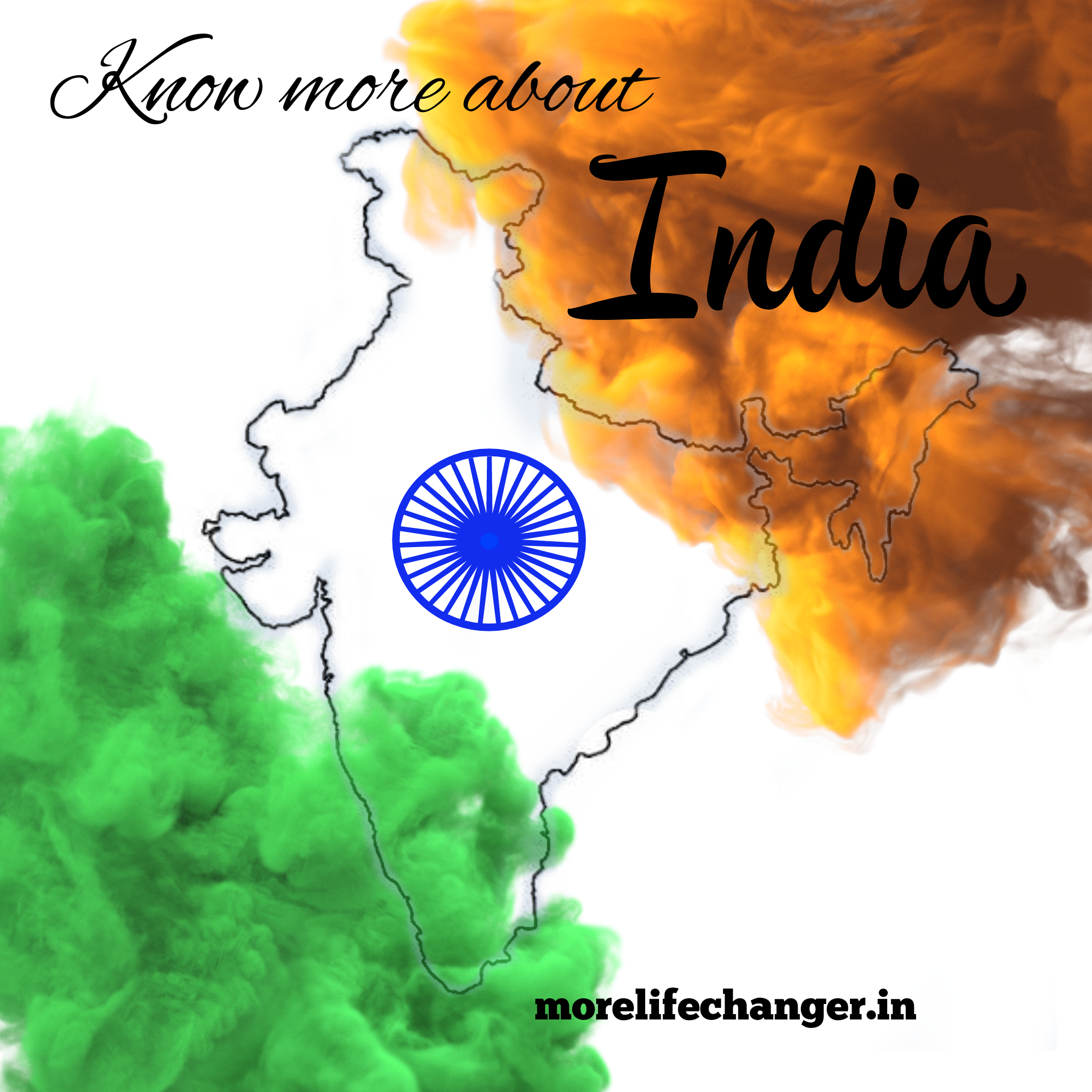India is a country located in South Asia and is the seventh-largest country in the world by land area. It is bounded by the Indian Ocean to the south, the Arabian Sea to the southwest, and the Bay of Bengal to the southeast. The capital of India is New Delhi, and the country has a population of over 1.3 billion people, making it the second-most populous country in the world after China.
India has a rich history that dates back thousands of years, with ancient civilizations such as the Indus Valley Civilization and the Mauryan Empire.
India is known for its diverse culture, cuisine, and religions. Hinduism is the most widely practiced religion in the country, followed by Islam, Christianity, and Sikhism. India is also known for its bustling cities, stunning natural beauty, and iconic landmarks
The economy of India is one of the fastest-growing in the world, with a focus on industries such as information technology, manufacturing, and agriculture. The country is also known for its thriving film industry
History of India that we all study
The history of India is long and rich, spanning thousands of years and marked by the rise and fall of numerous empires, kingdoms, and dynasties. Here is a brief overview of some of the key periods and events in Indian history:
Indus Valley Civilization (2600 BCE – 1900 BCE):
The Indus Valley Civilization was an ancient civilization that flourished in the northwestern region of the Indian subcontinent. It is known for its well-planned cities, advanced systems of drainage, and use of a unique script that has yet to be fully deciphered.
Vedic Period (1500 BCE – 500 BCE):
The Vedic Period is marked by the composition of the Vedas, a collection of ancient Hindu texts that include hymns, prayers, and rituals. The period saw the development of Hinduism and the rise of the caste system.
Mauryan Empire (321 BCE – 185 BCE):
The Mauryan Empire was one of the largest and most powerful empires in ancient India, ruled by Emperor Ashoka who is known for his policies of non-violence and religious tolerance.
Gupta Empire (320 CE – 550 CE):
The Gupta Empire is known as a golden age of Indian civilization, marked by advances in science, mathematics, and the arts.
Mughal Empire (1526 CE – 1857 CE):
The Mughal Empire was a Muslim empire that ruled over a large part of India. It is known for its impressive architecture, including the Taj Mahal, and for its policy of religious tolerance.
British Raj (1858 CE – 1947 CE):
The British Raj refers to the period of British rule in India, which lasted for almost 90 years. It saw significant economic and infrastructural development, but also saw the exploitation and oppression of Indian people.

Independence Movement and Partition (1947 CE):
India gained independence from British rule in 1947, with the partition of India and the creation of Pakistan leading to the displacement of millions of people and significant violence.
Post-Independence Era: After independence, India became a republic and began focusing on social and economic development, including the adoption of a socialist economic model and the establishment of democratic institutions.
Today, India is a diverse and rapidly developing country with a rich cultural heritage and a complex history.
Also read : 30 Things to know more about Telangana and its culture
History of India that we don’t study
Ahom Dynasty
The Ahom Dynasty was a powerful kingdom that ruled over the region that is now Assam in Northeast India for over 600 years, from the 13th century until the 19th century. The Ahoms were originally a Tai-speaking people who migrated from Yunnan in China and established their kingdom in the Brahmaputra Valley.
The Ahom Dynasty is known for its military strength and the development of a sophisticated administrative system. They were able to successfully defend their kingdom against numerous invasions from neighboring kingdoms and empires, including the Mughals, the Burmese, and the Koch dynasty.
Under the Ahom rule, Assam saw significant economic and cultural development, with advances in agriculture, trade, and the arts. The Ahoms also made significant contributions to the region’s architecture and art, with notable examples being the Sivasagar temples and the Rang Ghar pavilion.
The Ahom Dynasty came to an end in the early 19th century when the kingdom was annexed by the British East India Company after the First Anglo-Burmese War. However, the legacy of the Ahoms lives on in Assam, with many aspects of their culture and traditions still present in the region today.
Maratha Empire
Shivaji Maharaj, also known as Chhatrapati Shivaji Maharaj, was a 17th century Indian warrior king and the founder of the Maratha Empire in western India. He was born in 1630 in the fort of Shivneri near Pune in Maharashtra, and was raised by his mother Jijabai after his father’s death.
Shivaji Maharaj is known for his military and strategic prowess, and for his efforts to establish a sovereign Hindu state in a time when India was under the rule of the Mughal Empire. He was a skilled guerrilla fighter and is credited with developing the concept of guerilla warfare in India. He also had a strong navy and was successful in establishing control over key ports along the western coast of India.
Shivaji Maharaj is remembered for his bravery, his administrative reforms, and his promotion of the Marathi language and culture. He was a staunch Hindu and is known for his promotion of religious tolerance in his kingdom, allowing freedom of worship for all religions.
Shivaji Maharaj’s legacy lives on in Maharashtra, where he is revered as a hero and a symbol of Maratha pride. He is celebrated annually on Shivaji Jayanti, a public holiday in Maharashtra and other parts of India.
Chola Empire
The Chola Empire was a powerful dynasty that ruled over a large part of South India and parts of Sri Lanka from the 9th to the 13th century CE. The Cholas are known for their administrative and military achievements, as well as their patronage of art and architecture.
The Chola dynasty was founded by Vijayalaya Chola in the 9th century, and reached its zenith under the rule of Rajaraja Chola and his son Rajendra Chola in the 11th century. They were known for their extensive conquests, including the subjugation of the kingdoms of Sri Lanka and parts of Southeast Asia.
The Cholas also made significant contributions to the development of Tamil language and literature, and patronized the construction of numerous temples and other architectural structures. Some of the notable examples of Chola architecture include the Brihadeeswarar Temple in Thanjavur and the Airavatesvara Temple in Darasuram.
The Chola dynasty declined in the 13th century due to various factors, including the invasion of the Pandyas and the rise of the Hoysalas and the Kakatiyas in South India. However, their legacy lives on in Tamil Nadu and other parts of South India, where they are remembered as one of the greatest dynasties in Indian history.
Kings before Mauryan Empire
Some of the prominent kingdoms and dynasties that existed before the Mauryas include:
The Magadha Empire:
The Magadha Empire was one of the most powerful empires in ancient India, with its capital located at Pataliputra (modern-day Patna). The empire was founded in the 6th century BCE by Bimbisara, and was later ruled by powerful monarchs such as Ajatashatru, Udayin, and Mahapadma Nanda.
The Nanda Dynasty:
The Nanda dynasty ruled the Magadha Empire from the mid-4th century BCE to the early 3rd century BCE. They were known for their wealth and power, and were overthrown by Chandragupta Maurya, who founded the Mauryan Empire.
The Satavahanas:
The Satavahanas were a dynasty that ruled over parts of South India from the 1st century BCE to the 3rd century CE. They were known for their patronage of Buddhism and for their maritime trade with other parts of the world.
The Kushan Empire:
The Kushan Empire was a powerful empire that ruled over parts of Central Asia and northern India from the 1st century CE to the 3rd century CE. They were known for their military might, their promotion of trade and commerce, and their patronage of art and culture.
The Mahajanapadas:
The Mahajanapadas were a group of sixteen powerful kingdoms that existed in northern India in the 6th century BCE. They were known for their complex political systems and for their important role in the rise of Buddhism and Jainism.
The Achaemenid Empire:
The Achaemenid Empire was a Persian empire that ruled over parts of modern-day India in the 6th and 5th centuries BCE. They were known for their vast territory, their impressive military campaigns, and their promotion of trade and commerce.
The Pandya Dynasty:
The Pandya dynasty was a powerful dynasty that ruled over parts of South India from the 3rd century BCE to the 16th century CE. They were known for their maritime trade, their patronage of literature and the arts, and their extensive temple-building projects.
Cruelty of British Empire
The British Empire’s rule in India, which lasted from the mid-18th century to the mid-20th century, was marked by numerous instances of cruelty, exploitation, and oppression. Here are a few examples:
. Economic Exploitation:
The British East India Company established a monopoly on trade in India, which allowed them to control and exploit the country’s vast resources for their own profit. They forced Indian farmers to grow cash crops like indigo instead of food crops, which led to famines and widespread starvation. They also levied heavy taxes on the Indian population, causing widespread poverty and debt.
. Racial Discrimination:
The British believed in their racial superiority, and Indian people were treated as inferior subjects. They implemented policies that favored British citizens over Indians in terms of education, employment, and political representation. The Indian people were also subjected to racist attitudes and discriminatory laws.
. Cultural Suppression:
The British saw Indian culture as primitive and inferior, and they tried to suppress Indian traditions and values. They destroyed temples, monuments, and other cultural sites, and banned traditional practices like sati (widow burning) and thagi (organized crime). They also imposed their own culture and language on the Indian people, leading to the decline of many indigenous languages and traditions.
. Violence and Oppression:
The British used violence and force to maintain their control over India. They carried out numerous massacres and acts of brutality, including the Jallianwala Bagh Massacre in 1919, in which British troops killed hundreds of unarmed Indian protesters. They also used torture and imprisonment to suppress political dissent, and many Indian leaders were jailed or executed for speaking out against British rule.
. Partition of India:
In 1947, the British government decided to partition India into two separate countries, India and Pakistan. The partition led to one of the largest mass migrations in history, with millions of Hindus, Muslims, and Sikhs forced to flee their homes and move to the new countries. The partition was marked by widespread violence and bloodshed, with estimates of up to one million people killed.
. Forced Labor:
The British Empire used forced labor to extract resources and build infrastructure in India. Millions of Indians were forced to work on projects like the construction of railways, roads, and canals, often in dangerous and inhumane conditions. Many workers died from disease, exhaustion, or accidents, and they were not compensated for their labor.
. Salt Tax:
The British Empire imposed a tax on salt, which was a basic necessity for the Indian people. Mahatma Gandhi led the Salt March in 1930 to protest the tax, and the movement became a symbol of India’s struggle for independence. The British government responded with violence and repression, and many protesters were jailed or killed.
. Divide and Rule Policy:
The British Empire implemented a “divide and rule” policy to maintain their control over India. They played different religious and ethnic groups against each other, exacerbating existing tensions and creating new conflicts. This policy led to communal violence and sectarianism, which continue to plague India today.
. Education:
The British Empire established an education system in India that was designed to produce a small class of Indian elites who could serve as intermediaries between the British rulers and the Indian population. The curriculum was heavily focused on British culture and values, and the Indian students were discouraged from learning about their own history and culture. This legacy is still felt today, with many Indian students feeling disconnected from their own heritage and history.
. Deindustrialization:
The British Empire destroyed many of India’s traditional industries, such as textiles, in order to protect British manufacturing. This led to widespread unemployment and poverty, as millions of Indian workers were left without work. The legacy of deindustrialization is still felt in India today, with many parts of the country struggling with high levels of unemployment and underemployment.
. Land Ownership:
The British Empire introduced a system of private property ownership in India, which replaced traditional forms of land tenure. This led to the concentration of land in the hands of a small elite, who used their power to exploit the poor and marginalized. Today, India continues to struggle with issues of land ownership and distribution, as many farmers and landless workers are denied access to land and other resources.
. Environmental Degradation:
The British Empire’s policies led to widespread environmental degradation in India, as forests were cleared for agriculture and industry, and rivers were polluted by industrial waste. This legacy is still felt today, with India facing major environmental challenges, including air and water pollution, deforestation, and climate change.
The amount of money British looted from India
One widely cited estimate is that the British looted around $45 trillion from India during the period of their rule, which lasted for more than 200 years. This estimate is based on a study by the economist Utsa Patnaik, who calculated the total value of India’s GDP between 1765 and 1938, adjusted for inflation. Patnaik argues that India’s GDP would have been much higher if the British had not siphoned off so much wealth from the country.
These are some 100 things to know more about India which will make you proud Indian.
Please join discussion on Facebook about world facts and its secret.

